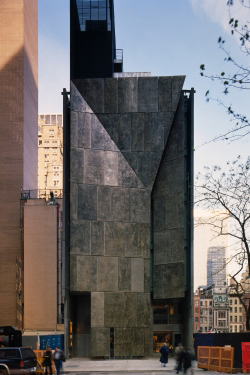
Museum of American Folk Art (for now), Tod Williams Billie Tsien Associates; Photo, Michael Moran.
If I weren't so behind the 8 ball these days, I would have posted yesterday about the not-so-shocking news that the Metropolitan Museum of Art will soon take over Breuer's Whitney (after that museum decamps to the High Line) and the sad news that the Musuem of Modern Art will be buying the Museum of American Folk Art. The first seems the best case scenario for the Whitney, since its current leadership doesn't seem to respect the architecture (link is to my post, "My .02 on the Whitney") and is chasing the contemporary dream, and the Met has plenty of the big mid-century paintings the Whitney was made for. Ellsworth Kelly, please.
The second makes me very sad. But Justin Davidson, in New York, says pretty much everything I would have.
The photograph above is from just as the Folk Art building was completed in 2001. Herbert Muschamp's New York Times review heralded the building as the beginning of New York's post-9/11 rebirth. But in a spatial sense, the writing was on the wall for the building the minute MoMA's expansion opened in 2004. The masonary building on the left is gone, now an empty lot owned by MoMA that may one day be filled by Jean Nouvel's Tower Verre. The gap on the right is now the far end of the glassy Yoshio Taniguchi buildings, the tower. Folk Art sticks out like a sore, crafty thumb on a block of neo-modern, high modern and early modern facades, a block owned by MoMA aesthetically and now economically. What the MoMA expansion did to the TWBTA building was a version of what Michael Graves's expansion proposals might have done to the Whitney: bury something beautiful in an architecture that is its antithesis.The odious term “starchitecture” gives the impression that Williams and Tsien’s design self-indulgently overwhelms the contents. Hardly: The little museum that couldn’t was largely made inconsequential by the presence of MoMA, which is gobbling up the entire block and monopolizing attention. What tourist or art-world regular, emerging from four hours spent wandering among Pollocks and Picassos, has the fortitude to say: “Hey, why don’t we duck into that cute little Folk Art Museum next door?”
Jerry’s critique of the interiors is potentially more damning, but his objections focus mostly on the paucity of horizontal space and the profusion of staircases. I understand those frustrations, but in midtown Manhattan, 30,000 square feet of broad, open galleries represent an imperial scale of luxury. MoMA can afford that; the Folk Art Museum never could, which is why it bought a small lot and asked its architects for a vertical museum. Williams and Tsien created not just one up-and-down, take-it-or-leave-it pathway, but a set of vertical itineraries that rise toward the sun filtering through the skylight at the top. The architects didn’t just do the best they could; they did far more than anyone had a right to expect.
But no architectural finesse can compensate for inadequate management, overreach, poor timing, or bad luck.

Whitney Expansion Proposal, Michael Graves (via New York Observer)
There's no way the MoMA will keep this building. It will be a backwater, unless they install something like "Starry Night" at the top of the tricky stairs. It doesn't suit the collection, their gallery style, or their pursuit of spaces for contmporary art (so parallel to the Whitney's). In a strange way, the restricted floorplate of the Folk Art museum is a throwback to the MoMA's genteel origins. The museum started in a set of brownstones, and it obliterated them as part of its march forward. So, inevitably, will this little museum go.
